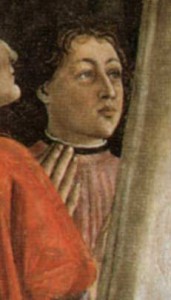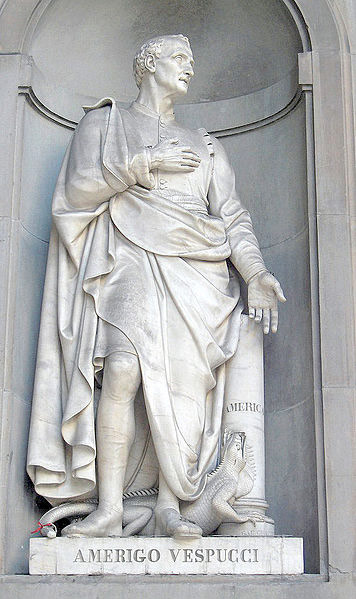 Amerigo Vespucci (March 9, 1454 to February 22, 1512) was born and grew up in Florence, Italy. His father, Ser Nastagio, was a Florentine Notary. He was educated by his uncle, Fra Giorgio Antionia Vespucci, who was a friar belonging to the Dominical Order in San Marco, Florence. The Americas are generally believed to have been named after him.
Amerigo Vespucci (March 9, 1454 to February 22, 1512) was born and grew up in Florence, Italy. His father, Ser Nastagio, was a Florentine Notary. He was educated by his uncle, Fra Giorgio Antionia Vespucci, who was a friar belonging to the Dominical Order in San Marco, Florence. The Americas are generally believed to have been named after him.
Early Years
Amerigo Vespucci was the youngest of three sons. While his elder siblings went to the University of Pisa to study, Vespucci joined as a clerk in a Florentine business house headed by Lorenzo di Pierfrancesco d’Medici, the head of the house of Medici. In Lorenzo de Medici Jr. he found a patron and gained his trust. Vespucci was sent by him to investigate the Medici branch in Cadiz, Spain. This was a turning point of his life and his long association with the sea. He was appointed as the executor of the estate of Giannotto Berardi, an Italian merchant who had died around that time in Seville. Vespucci fulfilled Berardi’s outstanding contract to provide twelve vessels to the Castilian crown for expeditions to the West Indies. After completing the contract, Vespucci kept on working as a supply contractor and records show that he supplied the beef requirements for one, possibly two, of Christopher Columbus’ expeditions.
Expeditions to the New Continent
Amerigo Vespucci’s association with ships came to the attention of King Manuel I of Portugal. He was invited to be an observer in several of the voyages made to the east coast of South America between 1499 and 1502. Brazil, at latitude of 16°52’ S, had been discovered earlier and was claimed by Portugal under the Treaty of Tordesillas. King Manuel wished to know if Brazil was only an island or part of the mainland of the new continent which Spanish explorers had discovered further north. Since Vespucci had already been to the Brazilian shoulder, he was the natural choice for the King. Though Vespucci was supposed to have made four voyages, historians are doubtful of the veracity of some of the claims. Of the four voyages, almost all historians concur with recorded events of the third voyage, while the other voyages have been mired in controversy.
The First Voyage
 The evidence for this voyage is based on a letter, published in 1504, which is supposed to be an account of the voyage written by Vespucci to Soderini. This letter claims that Vespucci made a lengthy visit to the New World after leaving Spain in May 1497 and returning in October 1498. Modern scholars and historians doubt if this voyage ever took place and regard the letter as a forgery. However, the letter does mention several native customs such as the use of hammocks and sweat lodges, which was not common knowledge and must have been from a source who had been to the New World.
The evidence for this voyage is based on a letter, published in 1504, which is supposed to be an account of the voyage written by Vespucci to Soderini. This letter claims that Vespucci made a lengthy visit to the New World after leaving Spain in May 1497 and returning in October 1498. Modern scholars and historians doubt if this voyage ever took place and regard the letter as a forgery. However, the letter does mention several native customs such as the use of hammocks and sweat lodges, which was not common knowledge and must have been from a source who had been to the New World.
The Second Voyage
Around 1499 or 1500, Vespucci took part in an expedition in the service of Spain under the command of Alonso de Ojeda. The plan was to sail to the southern tip of the African mainland and from there to the Indian Ocean. They made landfall on the coast of Guyana and here the commander and Vespucci seem to have been separated. Vespucci sailed south and discovered the mouth of the Amazon River at 6°S. He then turned around and sailed to Trinidad as well as the Orinoco River. Thereafter he set sail to Spain via Hispaniola. In a letter to his patron, Lorenzo di Pierfrancesco de’Medici, Vespucci claimed to have determined his longitude celestially on August 23rd, 1499, but this claim is disputed and therefore the credibility of the letter has been questioned.
The Third Voyage
This voyage of Vespucci is the best recorded and has been accepted by scholars and historians. This Portuguese expedition, which departed from Lisbon, took place between 1501 and 1502 and was commanded by Goncalo Coelho. The expedition first set sail to Cape Verde and encountered two ships returning from India. In a letter from Cape Verde, Vespucci told of his intentions to sail west to Asia like the previous voyage. After reaching Brazil, they sailed south along the coast of South America till the Rio de Janeiro’s bay. As per his account, he reached the latitude of Patagonia before he turned back. This has been doubted by historians since he did not mention the broad estuary of Rio de la Plata, which he must have encountered when he ventured that far south. The Portuguese maps of South America, which were created after the voyages of Vespucci and Coelho, showed only Cananeia at 25°S as the southernmost point and in all probability this was the southernmost point reached by the expedition. However these expeditions revealed a vast new continent, which was much bigger than what was anticipated.
In the latter half of the expedition, Vespucci mapped Alpha and Beta Centauri and also the constellation Crux or the Southern Cross. These stars had been known to the Greeks, but due to gradual precession they had been lowered below the European horizon and had been forgotten in the mist of time. The position of these stars and constellations proved to be a valuable navigational aid to future expeditions.
Based on his observations, Vespucci wrote to d’Medici that the land mass they had explored was much larger than those described by Ptolemy or Marco Polo and therefore was an unknown new Continent and was the fourth continent after Europe, Africa and Asia.
The Fourth Voyage
The fourth voyage was supposed to have taken place from 1503 to 1504. However, information acquired on this voyage remains sketchy. Historians doubt if such a voyage did take place at all.
Recognition
In 1508, King Ferdinand of Spain appointed Vespucci as the Chief Navigator of Spain and paid him a huge salary. Vespucci was commissioned to found a School of Navigation so that maritime practices could be streamlined, standardized and modernized. Modern Navigational techniques were imparted in the school to Captains who were to command Spanish ships. Vespucci also developed a reasonably accurate method to determine longitude. Since determining longitude involved knowing the time at that position, this method could only be improved many years later when accurate chronometers were developed.
Vespucci earned a place in history with these voyages. The letters he wrote made the continent of America to be widely known to the Europeans. Vespucci had set the stage for future colonization of the new territories. He also made contributions to the history of navigation in a way that would shape the course of history.